Business Principles: Market, Innovation, Finance Assignment
VerifiedAdded on 2020/07/23
|9
|2975
|734
Homework Assignment
AI Summary
This assignment provides a comprehensive overview of key principles in business, covering market characteristics, business innovation, financial viability, marketing strategies, and legal obligations. The assignment explores the nature of interactions between businesses, the influence of market factors on organizational goals, and the legal requirements for starting a business. It defines business innovation, explains the uses of innovation models, and outlines the process of product or service development, including associated benefits, risks, and implications. The assignment also delves into the importance of financial viability, consequences of poor financial management, and financial terminology. Furthermore, it covers the uses of a budget, budget management, marketing principles, sales processes, market research, brand value, and the relationship between sales and marketing. The assignment utilizes examples, definitions, and explanations to provide a clear understanding of the fundamental concepts of business.
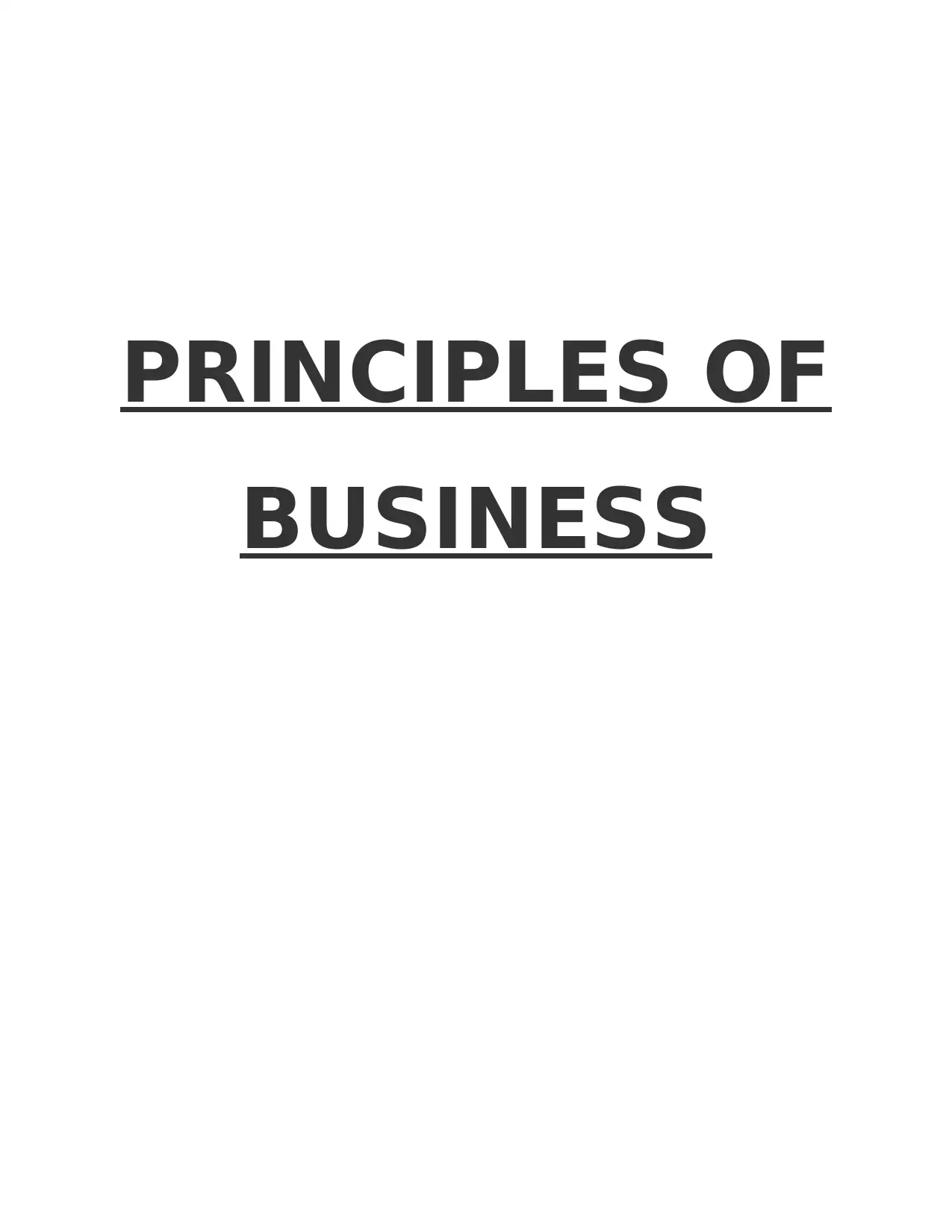
PRINCIPLES OF
BUSINESS
BUSINESS
Paraphrase This Document
Need a fresh take? Get an instant paraphrase of this document with our AI Paraphraser
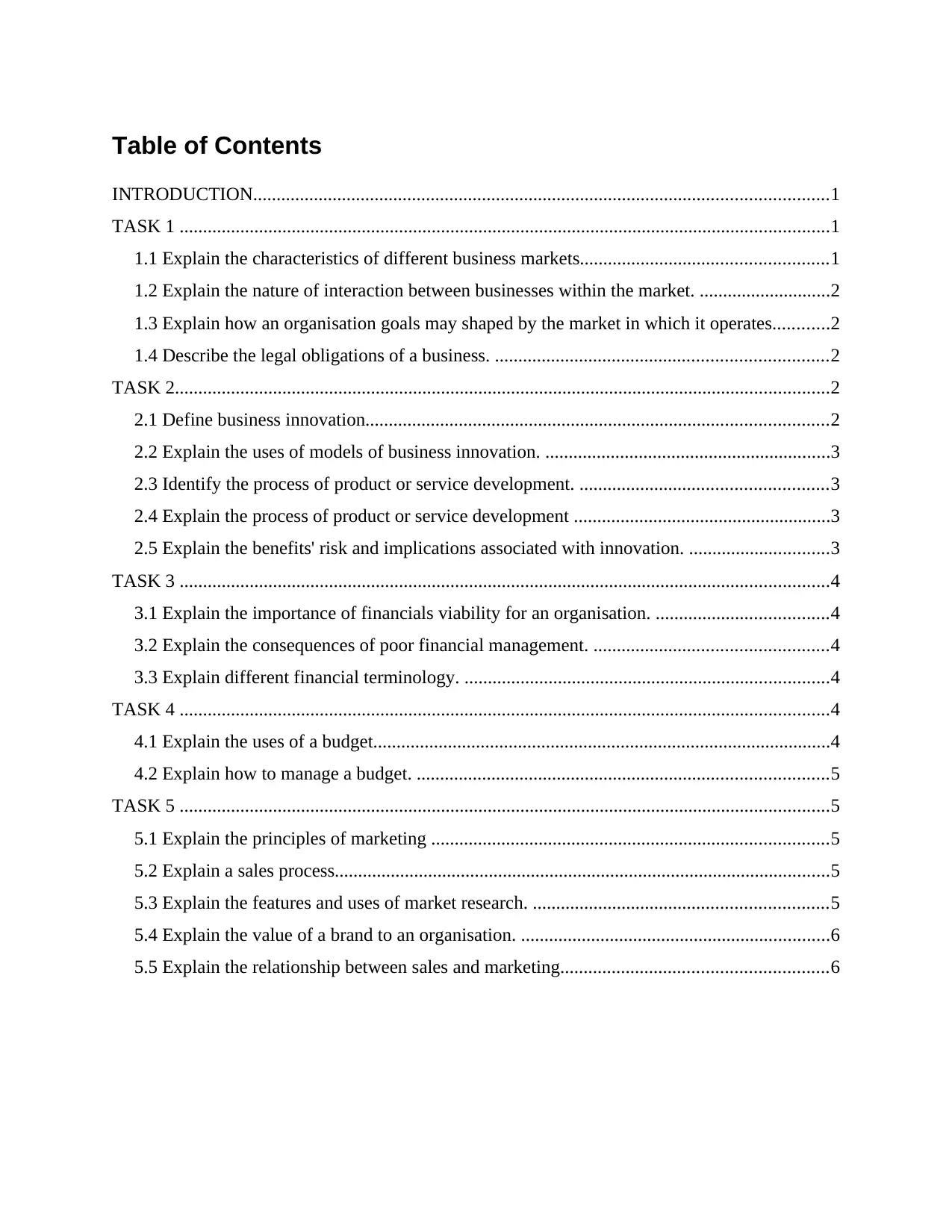
Table of Contents
INTRODUCTION...........................................................................................................................1
TASK 1 ...........................................................................................................................................1
1.1 Explain the characteristics of different business markets.....................................................1
1.2 Explain the nature of interaction between businesses within the market. ............................2
1.3 Explain how an organisation goals may shaped by the market in which it operates............2
1.4 Describe the legal obligations of a business. .......................................................................2
TASK 2............................................................................................................................................2
2.1 Define business innovation...................................................................................................2
2.2 Explain the uses of models of business innovation. .............................................................3
2.3 Identify the process of product or service development. .....................................................3
2.4 Explain the process of product or service development .......................................................3
2.5 Explain the benefits' risk and implications associated with innovation. ..............................3
TASK 3 ...........................................................................................................................................4
3.1 Explain the importance of financials viability for an organisation. .....................................4
3.2 Explain the consequences of poor financial management. ..................................................4
3.3 Explain different financial terminology. ..............................................................................4
TASK 4 ...........................................................................................................................................4
4.1 Explain the uses of a budget..................................................................................................4
4.2 Explain how to manage a budget. ........................................................................................5
TASK 5 ...........................................................................................................................................5
5.1 Explain the principles of marketing .....................................................................................5
5.2 Explain a sales process..........................................................................................................5
5.3 Explain the features and uses of market research. ...............................................................5
5.4 Explain the value of a brand to an organisation. ..................................................................6
5.5 Explain the relationship between sales and marketing.........................................................6
INTRODUCTION...........................................................................................................................1
TASK 1 ...........................................................................................................................................1
1.1 Explain the characteristics of different business markets.....................................................1
1.2 Explain the nature of interaction between businesses within the market. ............................2
1.3 Explain how an organisation goals may shaped by the market in which it operates............2
1.4 Describe the legal obligations of a business. .......................................................................2
TASK 2............................................................................................................................................2
2.1 Define business innovation...................................................................................................2
2.2 Explain the uses of models of business innovation. .............................................................3
2.3 Identify the process of product or service development. .....................................................3
2.4 Explain the process of product or service development .......................................................3
2.5 Explain the benefits' risk and implications associated with innovation. ..............................3
TASK 3 ...........................................................................................................................................4
3.1 Explain the importance of financials viability for an organisation. .....................................4
3.2 Explain the consequences of poor financial management. ..................................................4
3.3 Explain different financial terminology. ..............................................................................4
TASK 4 ...........................................................................................................................................4
4.1 Explain the uses of a budget..................................................................................................4
4.2 Explain how to manage a budget. ........................................................................................5
TASK 5 ...........................................................................................................................................5
5.1 Explain the principles of marketing .....................................................................................5
5.2 Explain a sales process..........................................................................................................5
5.3 Explain the features and uses of market research. ...............................................................5
5.4 Explain the value of a brand to an organisation. ..................................................................6
5.5 Explain the relationship between sales and marketing.........................................................6
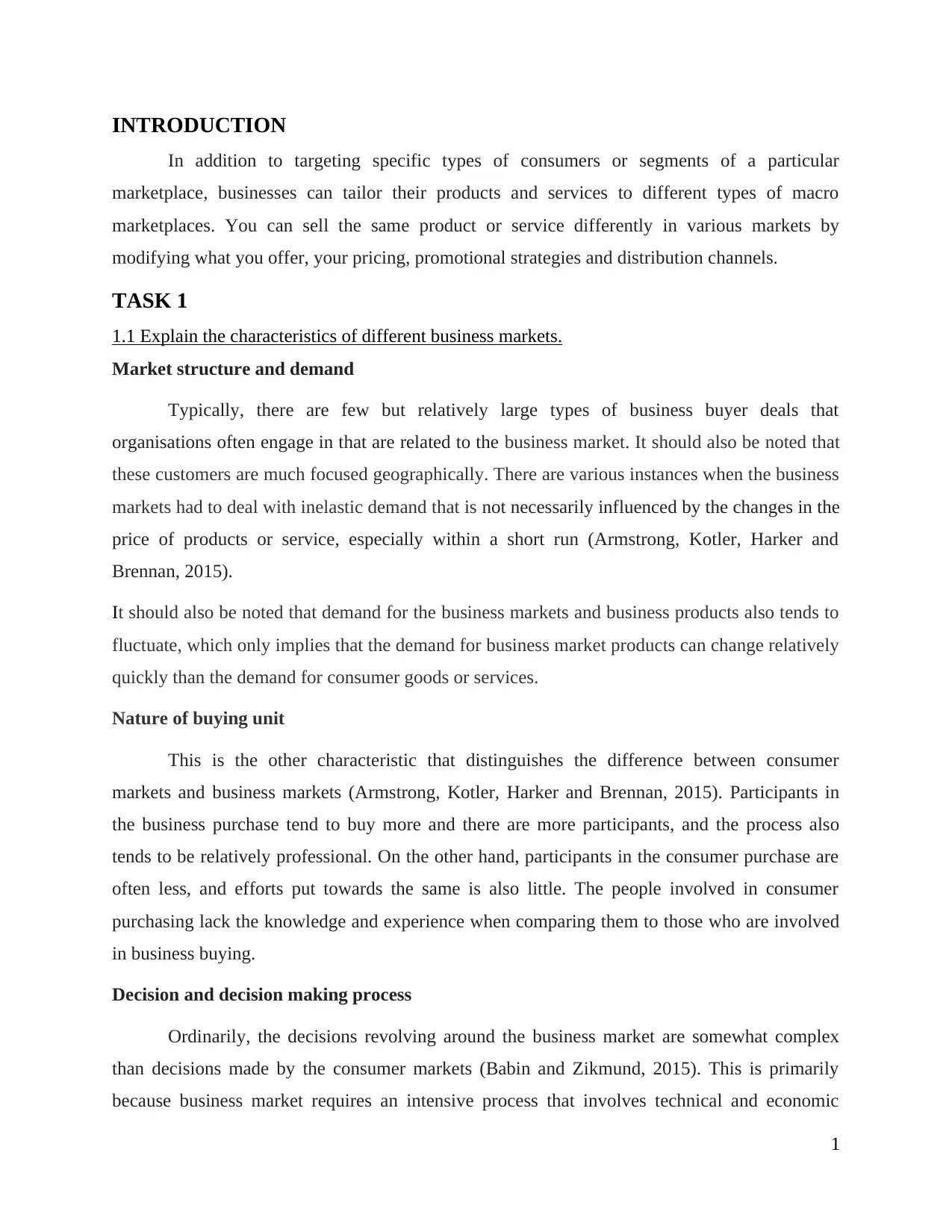
INTRODUCTION
In addition to targeting specific types of consumers or segments of a particular
marketplace, businesses can tailor their products and services to different types of macro
marketplaces. You can sell the same product or service differently in various markets by
modifying what you offer, your pricing, promotional strategies and distribution channels.
TASK 1
1.1 Explain the characteristics of different business markets.
Market structure and demand
Typically, there are few but relatively large types of business buyer deals that
organisations often engage in that are related to the business market. It should also be noted that
these customers are much focused geographically. There are various instances when the business
markets had to deal with inelastic demand that is not necessarily influenced by the changes in the
price of products or service, especially within a short run (Armstrong, Kotler, Harker and
Brennan, 2015).
It should also be noted that demand for the business markets and business products also tends to
fluctuate, which only implies that the demand for business market products can change relatively
quickly than the demand for consumer goods or services.
Nature of buying unit
This is the other characteristic that distinguishes the difference between consumer
markets and business markets (Armstrong, Kotler, Harker and Brennan, 2015). Participants in
the business purchase tend to buy more and there are more participants, and the process also
tends to be relatively professional. On the other hand, participants in the consumer purchase are
often less, and efforts put towards the same is also little. The people involved in consumer
purchasing lack the knowledge and experience when comparing them to those who are involved
in business buying.
Decision and decision making process
Ordinarily, the decisions revolving around the business market are somewhat complex
than decisions made by the consumer markets (Babin and Zikmund, 2015). This is primarily
because business market requires an intensive process that involves technical and economic
1
In addition to targeting specific types of consumers or segments of a particular
marketplace, businesses can tailor their products and services to different types of macro
marketplaces. You can sell the same product or service differently in various markets by
modifying what you offer, your pricing, promotional strategies and distribution channels.
TASK 1
1.1 Explain the characteristics of different business markets.
Market structure and demand
Typically, there are few but relatively large types of business buyer deals that
organisations often engage in that are related to the business market. It should also be noted that
these customers are much focused geographically. There are various instances when the business
markets had to deal with inelastic demand that is not necessarily influenced by the changes in the
price of products or service, especially within a short run (Armstrong, Kotler, Harker and
Brennan, 2015).
It should also be noted that demand for the business markets and business products also tends to
fluctuate, which only implies that the demand for business market products can change relatively
quickly than the demand for consumer goods or services.
Nature of buying unit
This is the other characteristic that distinguishes the difference between consumer
markets and business markets (Armstrong, Kotler, Harker and Brennan, 2015). Participants in
the business purchase tend to buy more and there are more participants, and the process also
tends to be relatively professional. On the other hand, participants in the consumer purchase are
often less, and efforts put towards the same is also little. The people involved in consumer
purchasing lack the knowledge and experience when comparing them to those who are involved
in business buying.
Decision and decision making process
Ordinarily, the decisions revolving around the business market are somewhat complex
than decisions made by the consumer markets (Babin and Zikmund, 2015). This is primarily
because business market requires an intensive process that involves technical and economic
1
⊘ This is a preview!⊘
Do you want full access?
Subscribe today to unlock all pages.

Trusted by 1+ million students worldwide
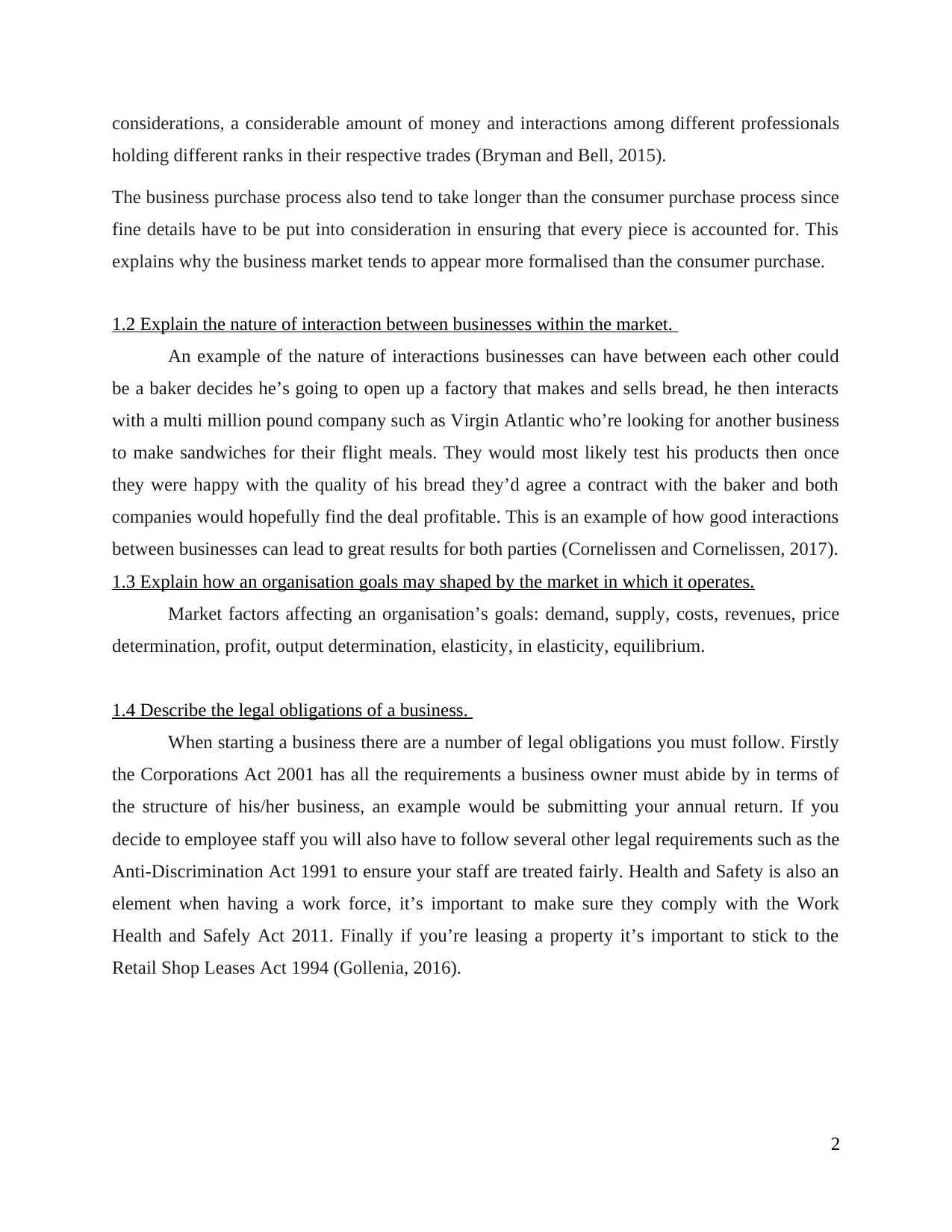
considerations, a considerable amount of money and interactions among different professionals
holding different ranks in their respective trades (Bryman and Bell, 2015).
The business purchase process also tend to take longer than the consumer purchase process since
fine details have to be put into consideration in ensuring that every piece is accounted for. This
explains why the business market tends to appear more formalised than the consumer purchase.
1.2 Explain the nature of interaction between businesses within the market.
An example of the nature of interactions businesses can have between each other could
be a baker decides he’s going to open up a factory that makes and sells bread, he then interacts
with a multi million pound company such as Virgin Atlantic who’re looking for another business
to make sandwiches for their flight meals. They would most likely test his products then once
they were happy with the quality of his bread they’d agree a contract with the baker and both
companies would hopefully find the deal profitable. This is an example of how good interactions
between businesses can lead to great results for both parties (Cornelissen and Cornelissen, 2017).
1.3 Explain how an organisation goals may shaped by the market in which it operates.
Market factors affecting an organisation’s goals: demand, supply, costs, revenues, price
determination, profit, output determination, elasticity, in elasticity, equilibrium.
1.4 Describe the legal obligations of a business.
When starting a business there are a number of legal obligations you must follow. Firstly
the Corporations Act 2001 has all the requirements a business owner must abide by in terms of
the structure of his/her business, an example would be submitting your annual return. If you
decide to employee staff you will also have to follow several other legal requirements such as the
Anti-Discrimination Act 1991 to ensure your staff are treated fairly. Health and Safety is also an
element when having a work force, it’s important to make sure they comply with the Work
Health and Safely Act 2011. Finally if you’re leasing a property it’s important to stick to the
Retail Shop Leases Act 1994 (Gollenia, 2016).
2
holding different ranks in their respective trades (Bryman and Bell, 2015).
The business purchase process also tend to take longer than the consumer purchase process since
fine details have to be put into consideration in ensuring that every piece is accounted for. This
explains why the business market tends to appear more formalised than the consumer purchase.
1.2 Explain the nature of interaction between businesses within the market.
An example of the nature of interactions businesses can have between each other could
be a baker decides he’s going to open up a factory that makes and sells bread, he then interacts
with a multi million pound company such as Virgin Atlantic who’re looking for another business
to make sandwiches for their flight meals. They would most likely test his products then once
they were happy with the quality of his bread they’d agree a contract with the baker and both
companies would hopefully find the deal profitable. This is an example of how good interactions
between businesses can lead to great results for both parties (Cornelissen and Cornelissen, 2017).
1.3 Explain how an organisation goals may shaped by the market in which it operates.
Market factors affecting an organisation’s goals: demand, supply, costs, revenues, price
determination, profit, output determination, elasticity, in elasticity, equilibrium.
1.4 Describe the legal obligations of a business.
When starting a business there are a number of legal obligations you must follow. Firstly
the Corporations Act 2001 has all the requirements a business owner must abide by in terms of
the structure of his/her business, an example would be submitting your annual return. If you
decide to employee staff you will also have to follow several other legal requirements such as the
Anti-Discrimination Act 1991 to ensure your staff are treated fairly. Health and Safety is also an
element when having a work force, it’s important to make sure they comply with the Work
Health and Safely Act 2011. Finally if you’re leasing a property it’s important to stick to the
Retail Shop Leases Act 1994 (Gollenia, 2016).
2
Paraphrase This Document
Need a fresh take? Get an instant paraphrase of this document with our AI Paraphraser
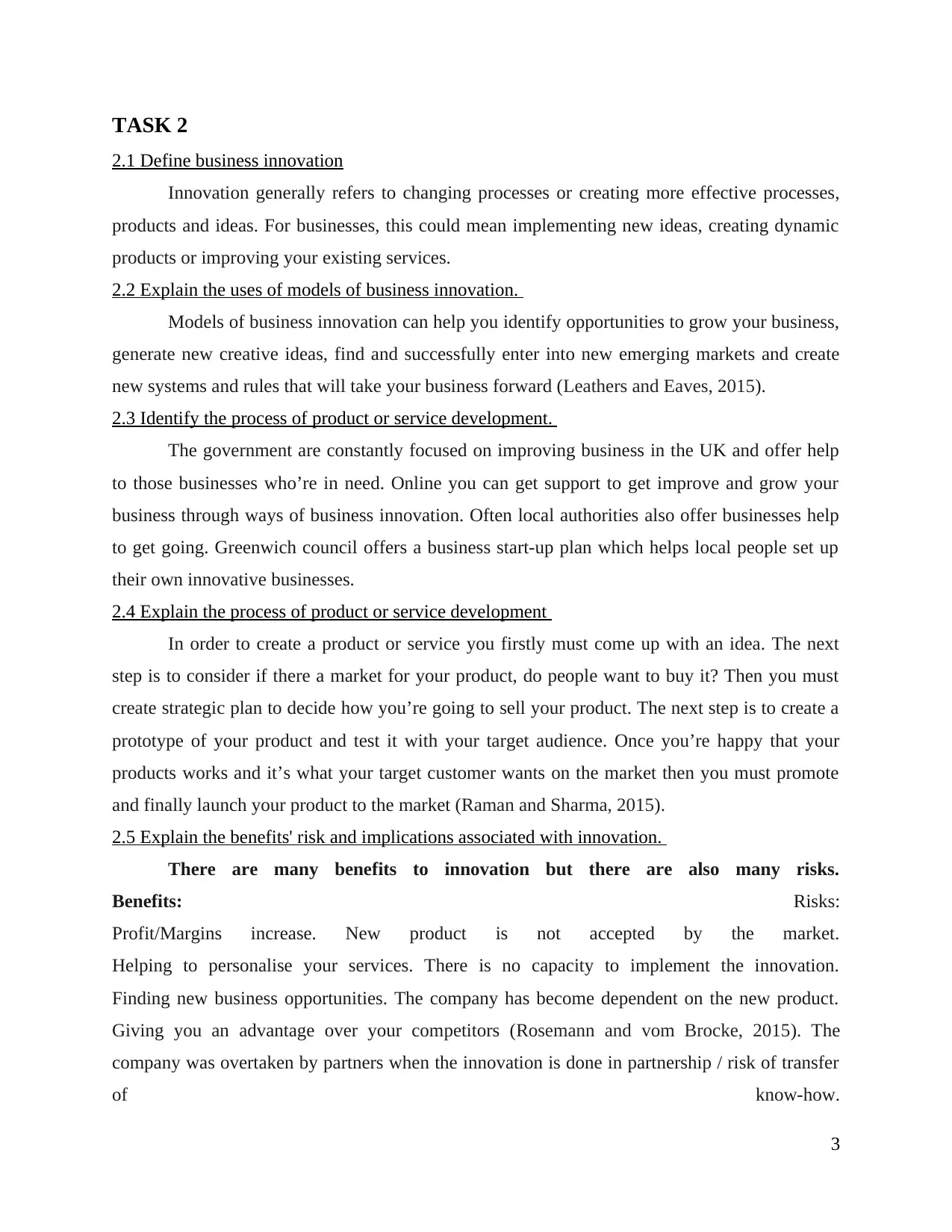
TASK 2
2.1 Define business innovation
Innovation generally refers to changing processes or creating more effective processes,
products and ideas. For businesses, this could mean implementing new ideas, creating dynamic
products or improving your existing services.
2.2 Explain the uses of models of business innovation.
Models of business innovation can help you identify opportunities to grow your business,
generate new creative ideas, find and successfully enter into new emerging markets and create
new systems and rules that will take your business forward (Leathers and Eaves, 2015).
2.3 Identify the process of product or service development.
The government are constantly focused on improving business in the UK and offer help
to those businesses who’re in need. Online you can get support to get improve and grow your
business through ways of business innovation. Often local authorities also offer businesses help
to get going. Greenwich council offers a business start-up plan which helps local people set up
their own innovative businesses.
2.4 Explain the process of product or service development
In order to create a product or service you firstly must come up with an idea. The next
step is to consider if there a market for your product, do people want to buy it? Then you must
create strategic plan to decide how you’re going to sell your product. The next step is to create a
prototype of your product and test it with your target audience. Once you’re happy that your
products works and it’s what your target customer wants on the market then you must promote
and finally launch your product to the market (Raman and Sharma, 2015).
2.5 Explain the benefits' risk and implications associated with innovation.
There are many benefits to innovation but there are also many risks.
Benefits: Risks:
Profit/Margins increase. New product is not accepted by the market.
Helping to personalise your services. There is no capacity to implement the innovation.
Finding new business opportunities. The company has become dependent on the new product.
Giving you an advantage over your competitors (Rosemann and vom Brocke, 2015). The
company was overtaken by partners when the innovation is done in partnership / risk of transfer
of know-how.
3
2.1 Define business innovation
Innovation generally refers to changing processes or creating more effective processes,
products and ideas. For businesses, this could mean implementing new ideas, creating dynamic
products or improving your existing services.
2.2 Explain the uses of models of business innovation.
Models of business innovation can help you identify opportunities to grow your business,
generate new creative ideas, find and successfully enter into new emerging markets and create
new systems and rules that will take your business forward (Leathers and Eaves, 2015).
2.3 Identify the process of product or service development.
The government are constantly focused on improving business in the UK and offer help
to those businesses who’re in need. Online you can get support to get improve and grow your
business through ways of business innovation. Often local authorities also offer businesses help
to get going. Greenwich council offers a business start-up plan which helps local people set up
their own innovative businesses.
2.4 Explain the process of product or service development
In order to create a product or service you firstly must come up with an idea. The next
step is to consider if there a market for your product, do people want to buy it? Then you must
create strategic plan to decide how you’re going to sell your product. The next step is to create a
prototype of your product and test it with your target audience. Once you’re happy that your
products works and it’s what your target customer wants on the market then you must promote
and finally launch your product to the market (Raman and Sharma, 2015).
2.5 Explain the benefits' risk and implications associated with innovation.
There are many benefits to innovation but there are also many risks.
Benefits: Risks:
Profit/Margins increase. New product is not accepted by the market.
Helping to personalise your services. There is no capacity to implement the innovation.
Finding new business opportunities. The company has become dependent on the new product.
Giving you an advantage over your competitors (Rosemann and vom Brocke, 2015). The
company was overtaken by partners when the innovation is done in partnership / risk of transfer
of know-how.
3
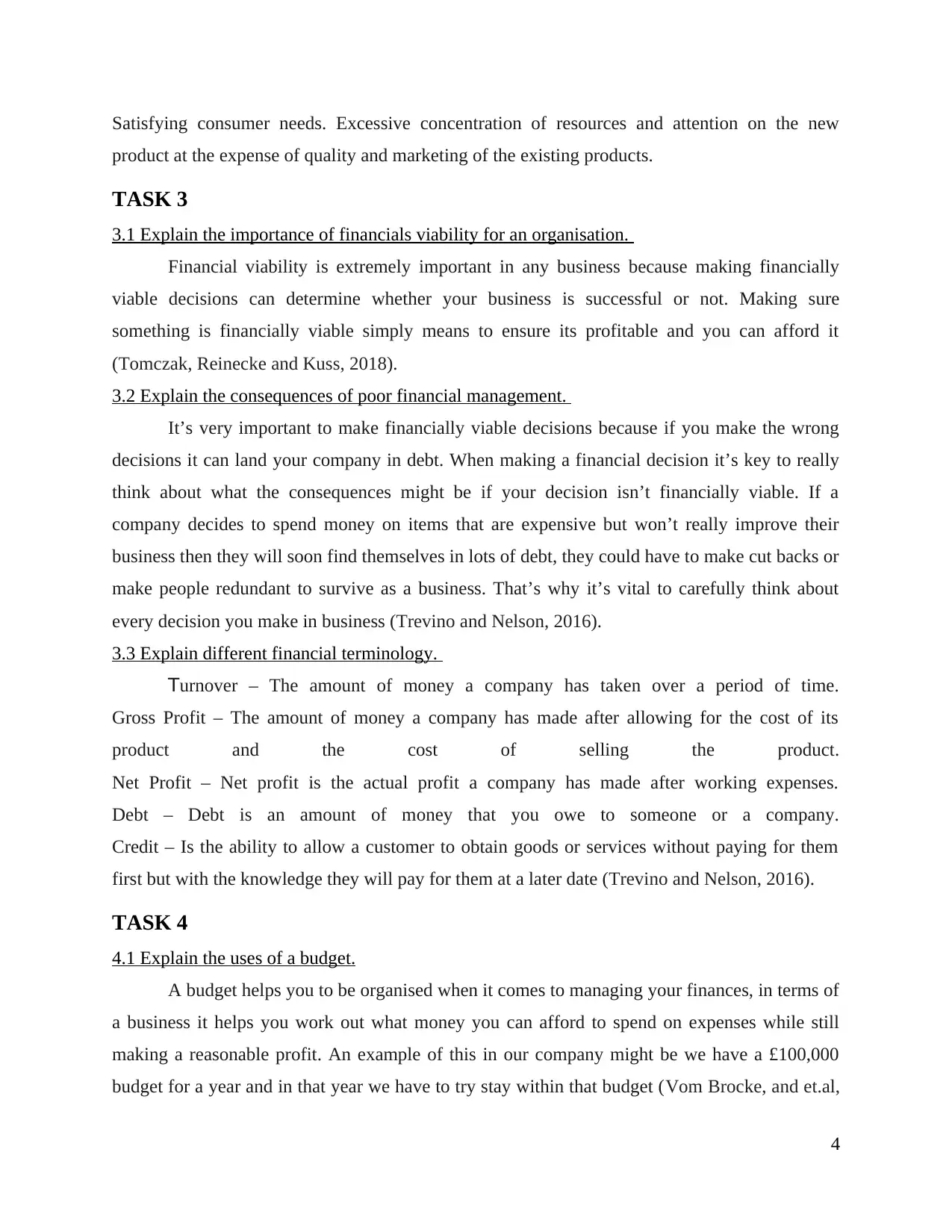
Satisfying consumer needs. Excessive concentration of resources and attention on the new
product at the expense of quality and marketing of the existing products.
TASK 3
3.1 Explain the importance of financials viability for an organisation.
Financial viability is extremely important in any business because making financially
viable decisions can determine whether your business is successful or not. Making sure
something is financially viable simply means to ensure its profitable and you can afford it
(Tomczak, Reinecke and Kuss, 2018).
3.2 Explain the consequences of poor financial management.
It’s very important to make financially viable decisions because if you make the wrong
decisions it can land your company in debt. When making a financial decision it’s key to really
think about what the consequences might be if your decision isn’t financially viable. If a
company decides to spend money on items that are expensive but won’t really improve their
business then they will soon find themselves in lots of debt, they could have to make cut backs or
make people redundant to survive as a business. That’s why it’s vital to carefully think about
every decision you make in business (Trevino and Nelson, 2016).
3.3 Explain different financial terminology.
Turnover – The amount of money a company has taken over a period of time.
Gross Profit – The amount of money a company has made after allowing for the cost of its
product and the cost of selling the product.
Net Profit – Net profit is the actual profit a company has made after working expenses.
Debt – Debt is an amount of money that you owe to someone or a company.
Credit – Is the ability to allow a customer to obtain goods or services without paying for them
first but with the knowledge they will pay for them at a later date (Trevino and Nelson, 2016).
TASK 4
4.1 Explain the uses of a budget.
A budget helps you to be organised when it comes to managing your finances, in terms of
a business it helps you work out what money you can afford to spend on expenses while still
making a reasonable profit. An example of this in our company might be we have a £100,000
budget for a year and in that year we have to try stay within that budget (Vom Brocke, and et.al,
4
product at the expense of quality and marketing of the existing products.
TASK 3
3.1 Explain the importance of financials viability for an organisation.
Financial viability is extremely important in any business because making financially
viable decisions can determine whether your business is successful or not. Making sure
something is financially viable simply means to ensure its profitable and you can afford it
(Tomczak, Reinecke and Kuss, 2018).
3.2 Explain the consequences of poor financial management.
It’s very important to make financially viable decisions because if you make the wrong
decisions it can land your company in debt. When making a financial decision it’s key to really
think about what the consequences might be if your decision isn’t financially viable. If a
company decides to spend money on items that are expensive but won’t really improve their
business then they will soon find themselves in lots of debt, they could have to make cut backs or
make people redundant to survive as a business. That’s why it’s vital to carefully think about
every decision you make in business (Trevino and Nelson, 2016).
3.3 Explain different financial terminology.
Turnover – The amount of money a company has taken over a period of time.
Gross Profit – The amount of money a company has made after allowing for the cost of its
product and the cost of selling the product.
Net Profit – Net profit is the actual profit a company has made after working expenses.
Debt – Debt is an amount of money that you owe to someone or a company.
Credit – Is the ability to allow a customer to obtain goods or services without paying for them
first but with the knowledge they will pay for them at a later date (Trevino and Nelson, 2016).
TASK 4
4.1 Explain the uses of a budget.
A budget helps you to be organised when it comes to managing your finances, in terms of
a business it helps you work out what money you can afford to spend on expenses while still
making a reasonable profit. An example of this in our company might be we have a £100,000
budget for a year and in that year we have to try stay within that budget (Vom Brocke, and et.al,
4
⊘ This is a preview!⊘
Do you want full access?
Subscribe today to unlock all pages.

Trusted by 1+ million students worldwide
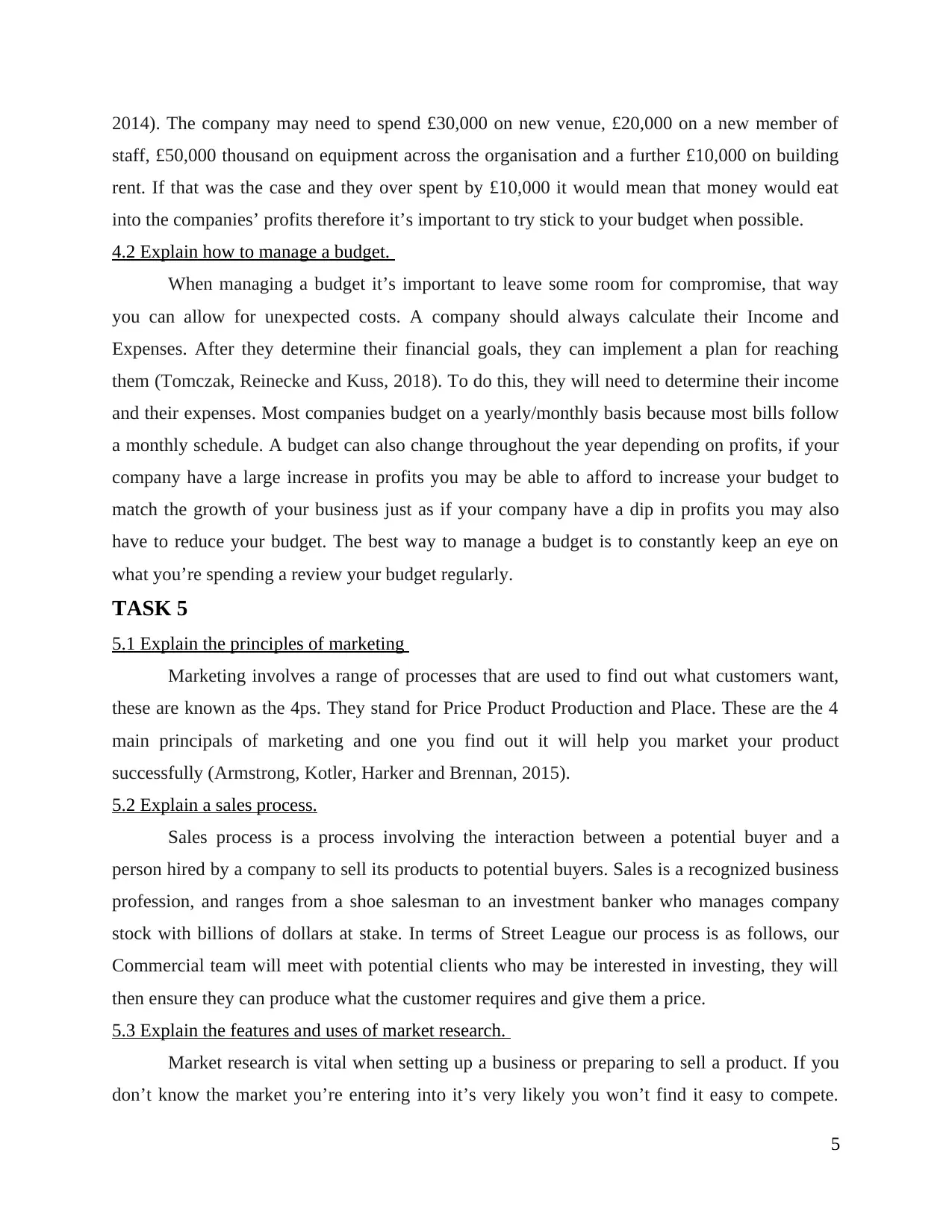
2014). The company may need to spend £30,000 on new venue, £20,000 on a new member of
staff, £50,000 thousand on equipment across the organisation and a further £10,000 on building
rent. If that was the case and they over spent by £10,000 it would mean that money would eat
into the companies’ profits therefore it’s important to try stick to your budget when possible.
4.2 Explain how to manage a budget.
When managing a budget it’s important to leave some room for compromise, that way
you can allow for unexpected costs. A company should always calculate their Income and
Expenses. After they determine their financial goals, they can implement a plan for reaching
them (Tomczak, Reinecke and Kuss, 2018). To do this, they will need to determine their income
and their expenses. Most companies budget on a yearly/monthly basis because most bills follow
a monthly schedule. A budget can also change throughout the year depending on profits, if your
company have a large increase in profits you may be able to afford to increase your budget to
match the growth of your business just as if your company have a dip in profits you may also
have to reduce your budget. The best way to manage a budget is to constantly keep an eye on
what you’re spending a review your budget regularly.
TASK 5
5.1 Explain the principles of marketing
Marketing involves a range of processes that are used to find out what customers want,
these are known as the 4ps. They stand for Price Product Production and Place. These are the 4
main principals of marketing and one you find out it will help you market your product
successfully (Armstrong, Kotler, Harker and Brennan, 2015).
5.2 Explain a sales process.
Sales process is a process involving the interaction between a potential buyer and a
person hired by a company to sell its products to potential buyers. Sales is a recognized business
profession, and ranges from a shoe salesman to an investment banker who manages company
stock with billions of dollars at stake. In terms of Street League our process is as follows, our
Commercial team will meet with potential clients who may be interested in investing, they will
then ensure they can produce what the customer requires and give them a price.
5.3 Explain the features and uses of market research.
Market research is vital when setting up a business or preparing to sell a product. If you
don’t know the market you’re entering into it’s very likely you won’t find it easy to compete.
5
staff, £50,000 thousand on equipment across the organisation and a further £10,000 on building
rent. If that was the case and they over spent by £10,000 it would mean that money would eat
into the companies’ profits therefore it’s important to try stick to your budget when possible.
4.2 Explain how to manage a budget.
When managing a budget it’s important to leave some room for compromise, that way
you can allow for unexpected costs. A company should always calculate their Income and
Expenses. After they determine their financial goals, they can implement a plan for reaching
them (Tomczak, Reinecke and Kuss, 2018). To do this, they will need to determine their income
and their expenses. Most companies budget on a yearly/monthly basis because most bills follow
a monthly schedule. A budget can also change throughout the year depending on profits, if your
company have a large increase in profits you may be able to afford to increase your budget to
match the growth of your business just as if your company have a dip in profits you may also
have to reduce your budget. The best way to manage a budget is to constantly keep an eye on
what you’re spending a review your budget regularly.
TASK 5
5.1 Explain the principles of marketing
Marketing involves a range of processes that are used to find out what customers want,
these are known as the 4ps. They stand for Price Product Production and Place. These are the 4
main principals of marketing and one you find out it will help you market your product
successfully (Armstrong, Kotler, Harker and Brennan, 2015).
5.2 Explain a sales process.
Sales process is a process involving the interaction between a potential buyer and a
person hired by a company to sell its products to potential buyers. Sales is a recognized business
profession, and ranges from a shoe salesman to an investment banker who manages company
stock with billions of dollars at stake. In terms of Street League our process is as follows, our
Commercial team will meet with potential clients who may be interested in investing, they will
then ensure they can produce what the customer requires and give them a price.
5.3 Explain the features and uses of market research.
Market research is vital when setting up a business or preparing to sell a product. If you
don’t know the market you’re entering into it’s very likely you won’t find it easy to compete.
5
Paraphrase This Document
Need a fresh take? Get an instant paraphrase of this document with our AI Paraphraser
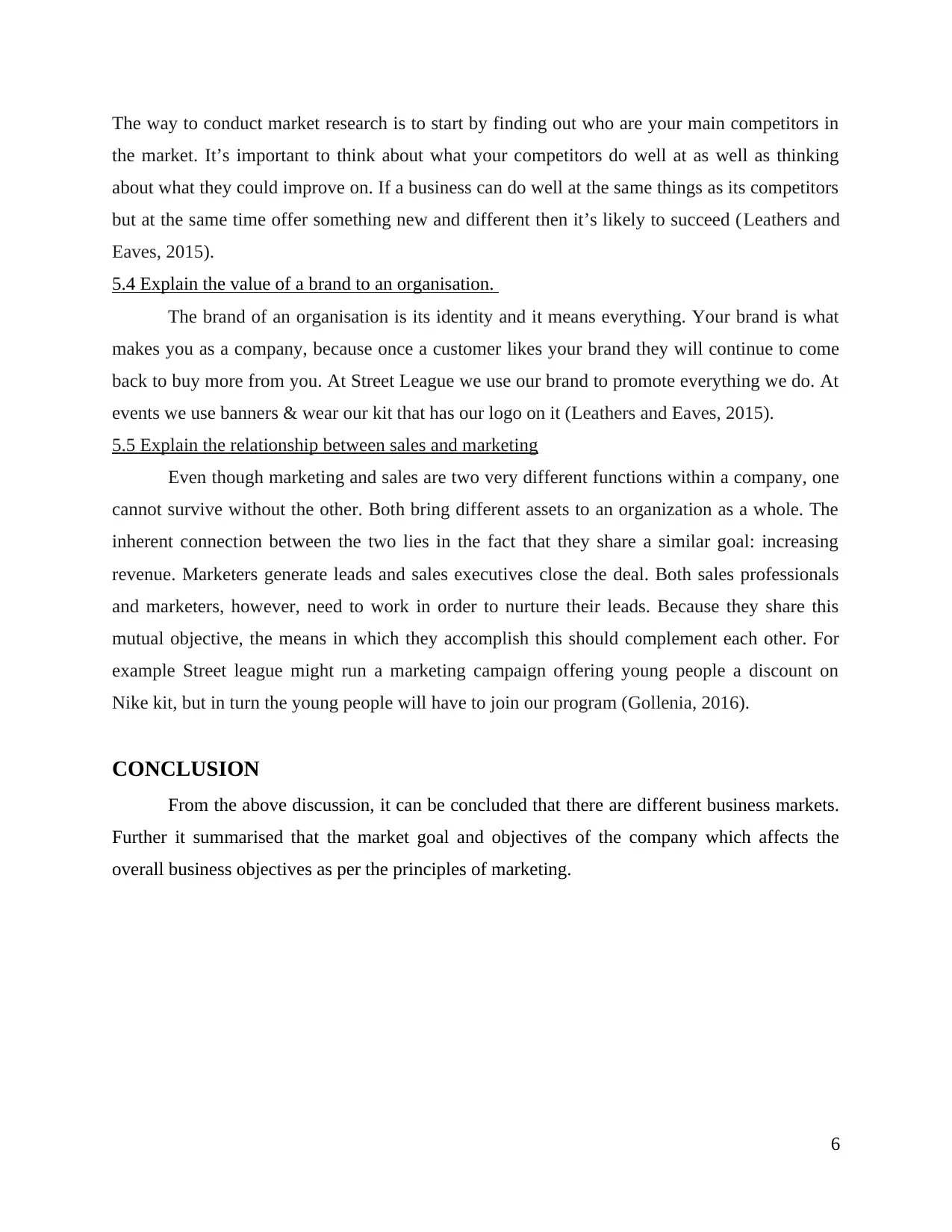
The way to conduct market research is to start by finding out who are your main competitors in
the market. It’s important to think about what your competitors do well at as well as thinking
about what they could improve on. If a business can do well at the same things as its competitors
but at the same time offer something new and different then it’s likely to succeed (Leathers and
Eaves, 2015).
5.4 Explain the value of a brand to an organisation.
The brand of an organisation is its identity and it means everything. Your brand is what
makes you as a company, because once a customer likes your brand they will continue to come
back to buy more from you. At Street League we use our brand to promote everything we do. At
events we use banners & wear our kit that has our logo on it (Leathers and Eaves, 2015).
5.5 Explain the relationship between sales and marketing
Even though marketing and sales are two very different functions within a company, one
cannot survive without the other. Both bring different assets to an organization as a whole. The
inherent connection between the two lies in the fact that they share a similar goal: increasing
revenue. Marketers generate leads and sales executives close the deal. Both sales professionals
and marketers, however, need to work in order to nurture their leads. Because they share this
mutual objective, the means in which they accomplish this should complement each other. For
example Street league might run a marketing campaign offering young people a discount on
Nike kit, but in turn the young people will have to join our program (Gollenia, 2016).
CONCLUSION
From the above discussion, it can be concluded that there are different business markets.
Further it summarised that the market goal and objectives of the company which affects the
overall business objectives as per the principles of marketing.
6
the market. It’s important to think about what your competitors do well at as well as thinking
about what they could improve on. If a business can do well at the same things as its competitors
but at the same time offer something new and different then it’s likely to succeed (Leathers and
Eaves, 2015).
5.4 Explain the value of a brand to an organisation.
The brand of an organisation is its identity and it means everything. Your brand is what
makes you as a company, because once a customer likes your brand they will continue to come
back to buy more from you. At Street League we use our brand to promote everything we do. At
events we use banners & wear our kit that has our logo on it (Leathers and Eaves, 2015).
5.5 Explain the relationship between sales and marketing
Even though marketing and sales are two very different functions within a company, one
cannot survive without the other. Both bring different assets to an organization as a whole. The
inherent connection between the two lies in the fact that they share a similar goal: increasing
revenue. Marketers generate leads and sales executives close the deal. Both sales professionals
and marketers, however, need to work in order to nurture their leads. Because they share this
mutual objective, the means in which they accomplish this should complement each other. For
example Street league might run a marketing campaign offering young people a discount on
Nike kit, but in turn the young people will have to join our program (Gollenia, 2016).
CONCLUSION
From the above discussion, it can be concluded that there are different business markets.
Further it summarised that the market goal and objectives of the company which affects the
overall business objectives as per the principles of marketing.
6
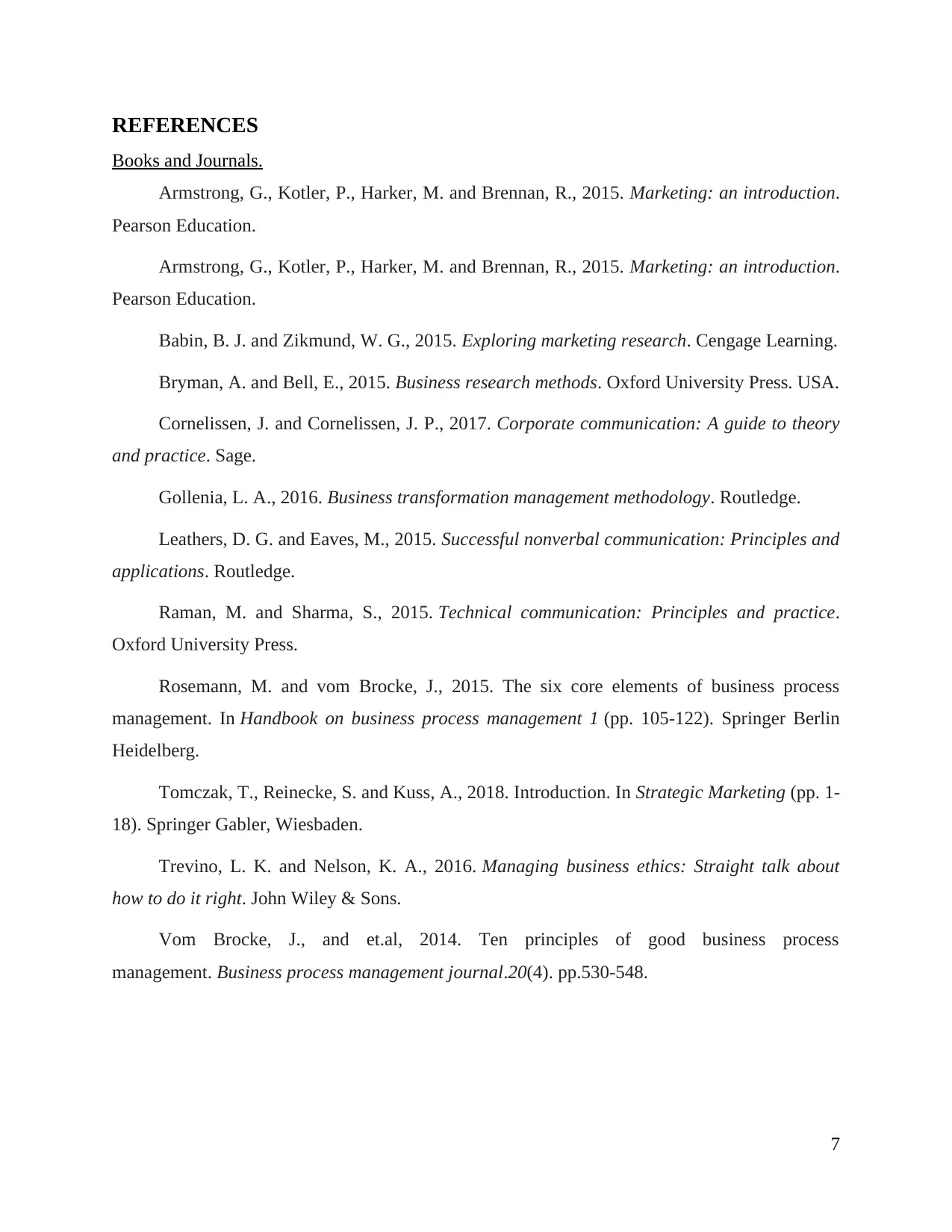
REFERENCES
Books and Journals.
Armstrong, G., Kotler, P., Harker, M. and Brennan, R., 2015. Marketing: an introduction.
Pearson Education.
Armstrong, G., Kotler, P., Harker, M. and Brennan, R., 2015. Marketing: an introduction.
Pearson Education.
Babin, B. J. and Zikmund, W. G., 2015. Exploring marketing research. Cengage Learning.
Bryman, A. and Bell, E., 2015. Business research methods. Oxford University Press. USA.
Cornelissen, J. and Cornelissen, J. P., 2017. Corporate communication: A guide to theory
and practice. Sage.
Gollenia, L. A., 2016. Business transformation management methodology. Routledge.
Leathers, D. G. and Eaves, M., 2015. Successful nonverbal communication: Principles and
applications. Routledge.
Raman, M. and Sharma, S., 2015. Technical communication: Principles and practice.
Oxford University Press.
Rosemann, M. and vom Brocke, J., 2015. The six core elements of business process
management. In Handbook on business process management 1 (pp. 105-122). Springer Berlin
Heidelberg.
Tomczak, T., Reinecke, S. and Kuss, A., 2018. Introduction. In Strategic Marketing (pp. 1-
18). Springer Gabler, Wiesbaden.
Trevino, L. K. and Nelson, K. A., 2016. Managing business ethics: Straight talk about
how to do it right. John Wiley & Sons.
Vom Brocke, J., and et.al, 2014. Ten principles of good business process
management. Business process management journal.20(4). pp.530-548.
7
Books and Journals.
Armstrong, G., Kotler, P., Harker, M. and Brennan, R., 2015. Marketing: an introduction.
Pearson Education.
Armstrong, G., Kotler, P., Harker, M. and Brennan, R., 2015. Marketing: an introduction.
Pearson Education.
Babin, B. J. and Zikmund, W. G., 2015. Exploring marketing research. Cengage Learning.
Bryman, A. and Bell, E., 2015. Business research methods. Oxford University Press. USA.
Cornelissen, J. and Cornelissen, J. P., 2017. Corporate communication: A guide to theory
and practice. Sage.
Gollenia, L. A., 2016. Business transformation management methodology. Routledge.
Leathers, D. G. and Eaves, M., 2015. Successful nonverbal communication: Principles and
applications. Routledge.
Raman, M. and Sharma, S., 2015. Technical communication: Principles and practice.
Oxford University Press.
Rosemann, M. and vom Brocke, J., 2015. The six core elements of business process
management. In Handbook on business process management 1 (pp. 105-122). Springer Berlin
Heidelberg.
Tomczak, T., Reinecke, S. and Kuss, A., 2018. Introduction. In Strategic Marketing (pp. 1-
18). Springer Gabler, Wiesbaden.
Trevino, L. K. and Nelson, K. A., 2016. Managing business ethics: Straight talk about
how to do it right. John Wiley & Sons.
Vom Brocke, J., and et.al, 2014. Ten principles of good business process
management. Business process management journal.20(4). pp.530-548.
7
⊘ This is a preview!⊘
Do you want full access?
Subscribe today to unlock all pages.

Trusted by 1+ million students worldwide
1 out of 9
Related Documents
Your All-in-One AI-Powered Toolkit for Academic Success.
+13062052269
info@desklib.com
Available 24*7 on WhatsApp / Email
![[object Object]](/_next/static/media/star-bottom.7253800d.svg)
Unlock your academic potential
Copyright © 2020–2025 A2Z Services. All Rights Reserved. Developed and managed by ZUCOL.





